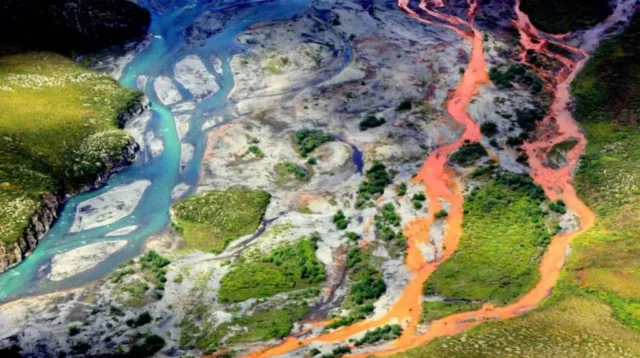Alarming Color Change in Alaska’s Rivers Linked to Permafrost Thaw
Have you ever imagined a landscape where pristine rivers turn into rusty-orange streams? In Alaska, this unsettling transformation is happening right before our eyes. Scientists from the National Park Service, U.S. Geological Survey, and the University of California, Davis, have identified that rising temperatures are thawing permafrost, releasing harmful metals into the water, resulting in this striking color change. This phenomenon is not just a visual spectacle; it represents a critical environmental issue that demands our attention.
Widespread Impact on the Northern Brooks Range
Over the last decade, a concerning transformation has unfolded across the northern Brooks Range. Approximately 75 streams have shown similar alarming changes in color and quality. According to John O’Donnell, an ecologist from the National Park Service, “The more flights we undertook over these regions, the more orange rivers we discovered.” Imagine flying over these otherworldly landscapes and realizing that a significant part of our natural heritage is being compromised. It is a stark reminder of how climate change is not just a distant concern—it’s happening now, and it’s impacting the ecosystems that many species, including humans, rely on.
Visible Pollution Levels: A New Kind of Crisis
The implications of this color shift go far beyond aesthetics. As highlighted by Brett Poulin, an associate professor of ecological toxicology, “Some of these rivers are even visible from space, indicating significant pollution levels.” This alarming observation echoes the urgency of addressing the environmental crisis. Chemical analyses reveal astonishing findings: these polluted waters are teeming with elevated concentrations of toxic elements like iron, zinc, nickel, copper, and even cadmium. For instance, one river in the Agashashok basin recorded a pH level of just 2.6—comparable to the acidity of lemon juice or vinegar. Such acidity can devastate aquatic ecosystems, leading to dead vegetation and a cascade of consequences for the wildlife that inhabits these areas.
Why This Matters
Understanding the gravity of this situation is crucial. The shift in river color is a “canary in the coal mine” for larger environmental shifts, serving as a warning sign that indicates the health of our planet. Studies show that climate change is a significant driver of permafrost thaw, with projections estimating a potential increase of 3 to 7 degrees Celsius in Arctic temperatures in the coming decades. As temperatures rise, more permafrost will thaw, releasing even more heavy metals and other toxic substances into freshwater sources.
What Can Be Done?
The time to act is now. Here are some unique steps we can take to combat this growing crisis:
- Advocate for Policy Change: Support legislation that aims to reduce greenhouse gas emissions and protect vulnerable ecosystems.
- Support Local Conservation Efforts: Engage with local organizations focused on river conservation. Your support can make a difference at the grassroots level.
- Raise Awareness: Share this information on social media to get others involved in protecting our environment.
- Engage in Sustainable Practices: Small actions like reducing waste, conserving water, and making sustainable transportation choices can collectively contribute to a healthier planet.
As we confront the challenges posed by climate change and environmental degradation, it becomes clear that awareness is only the first step. We must rally together and take actionable steps to safeguard the majestic rivers and landscapes that define our natural world.
Let us not wait until it’s too late. Together, we can make a difference for Alaska’s rivers and for our planet as a whole.






